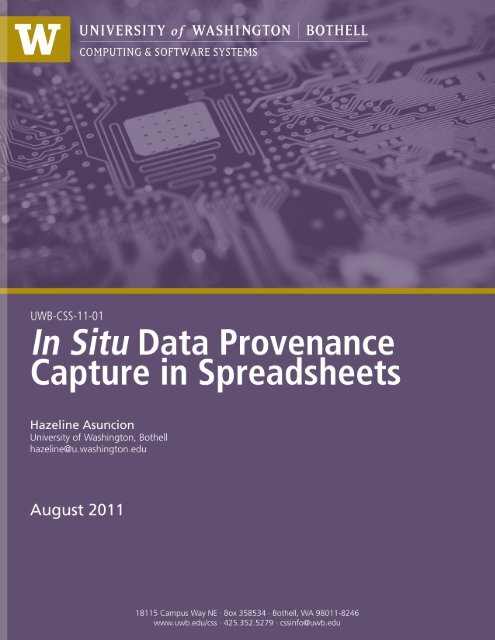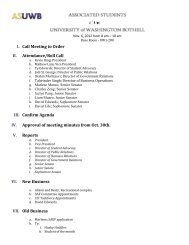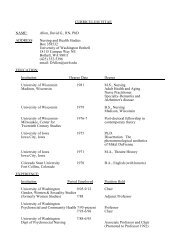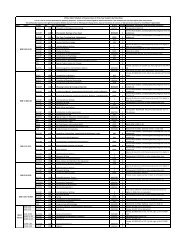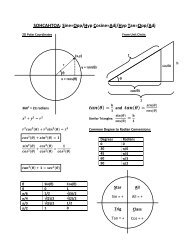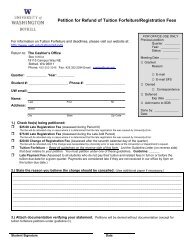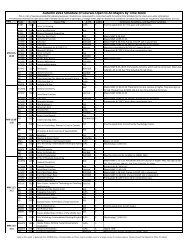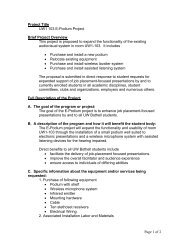In Situ Data Provenance Capture in Spreadsheets
In Situ - UW Bothell
In Situ - UW Bothell
- No tags were found...
You also want an ePaper? Increase the reach of your titles
YUMPU automatically turns print PDFs into web optimized ePapers that Google loves.
<strong>In</strong> <strong>Situ</strong> <strong>Data</strong> <strong>Provenance</strong> <strong>Capture</strong> <strong>in</strong> <strong>Spreadsheets</strong><br />
Hazel<strong>in</strong>e Asuncion<br />
Comput<strong>in</strong>g and Software Systems<br />
University of Wash<strong>in</strong>gton, Bothell<br />
Bothell, WA USA<br />
hazel<strong>in</strong>e@u.wash<strong>in</strong>gton.edu<br />
CSS Technical Report# UWB-CSS-11-01<br />
August 2011<br />
Abstract—The capture of data provenance is a fundamentally<br />
important task <strong>in</strong> eScience. While provenance can be captured<br />
us<strong>in</strong>g techniques such as scientific workflows, typically these<br />
techniques do not trace <strong>in</strong>ternal data manipulations that occur<br />
with<strong>in</strong> off-the-shelf analysis tools. Yet it is still essential to<br />
capture data provenance with<strong>in</strong> such environments. This paper<br />
discusses an <strong>in</strong> situ provenance approach for spreadsheet data <strong>in</strong><br />
MS Excel, a commonly used analysis environment among<br />
scientists. We describe the design and implementation of an<br />
Excel tool that captures provenance unobtrusively <strong>in</strong> the<br />
background, allows for user annotations, provides undo/redo<br />
functionality at various levels of task granularity, and presents<br />
the captured provenance <strong>in</strong> an accessible format to support a<br />
range of provenance queries for analysis. We also present several<br />
motivat<strong>in</strong>g use case scenarios and a user evaluation which<br />
suggests that our approach is both efficient and useful to<br />
scientists.<br />
Keywords: data provenance, <strong>in</strong> situ capture, spreadsheets<br />
I. INTRODUCTION<br />
<strong>Data</strong> provenance encompasses the orig<strong>in</strong> and history of data<br />
[20], <strong>in</strong>clud<strong>in</strong>g the series of process<strong>in</strong>g steps used <strong>in</strong> the data<br />
analysis or experiment [7]. <strong>Provenance</strong> is typically captured<br />
us<strong>in</strong>g a scientific workflow approach, as demonstrated by the<br />
plethora of workflow tools and techniques developed over the<br />
years [4, 10, 19]. Scientific workflows allow scientists to<br />
codify the design of an experiment or data analysis and to<br />
capture provenance dur<strong>in</strong>g workflow execution. Such an<br />
approach enables scientists to l<strong>in</strong>k together <strong>in</strong>dependent data<br />
processors <strong>in</strong> the form of executable code, scripts, or web<br />
services and to re-run this process<strong>in</strong>g pipel<strong>in</strong>e as needed [19].<br />
<strong>In</strong> many research contexts, however, the bulk of data<br />
analysis occurs with<strong>in</strong> off-the-shelf tools (such as MS Excel)<br />
which often fall out of the purview of standard workflow<br />
techniques. As an example, the Jaffe Atmospheric Science<br />
Research Group at the University of Wash<strong>in</strong>gton, Bothell<br />
(UWB) [1] has generated and processed many hundreds of<br />
datasets <strong>in</strong> the form of Excel spreadsheets over the years<br />
(derived from data sources such as the NOA, EPA, and<br />
NASA), s<strong>in</strong>ce Excel is one of the group’s primary data analysis<br />
tools. Later <strong>in</strong> this paper, we discuss motivat<strong>in</strong>g data<br />
provenance use cases tailored towards this research group.<br />
<strong>In</strong> such situations, it becomes necessary to support <strong>in</strong>ternal<br />
provenance capture with<strong>in</strong> the analysis tool itself. For <strong>in</strong>stance,<br />
if a scientist engages <strong>in</strong> exploratory data analysis <strong>in</strong> Excel and<br />
discovers an important result, it would be crucial to have the<br />
ability to retrace the process<strong>in</strong>g steps that led to the discovery.<br />
At the same time, the ideal provenance capture approach<br />
should be unobtrusive, with m<strong>in</strong>imal overhead to the user.<br />
Furthermore, the captured provenance should be accessible,<br />
easy to analyze, and lightweight <strong>in</strong> terms of storage.<br />
Our approach attempts to meet these ideal requirements <strong>in</strong><br />
the follow<strong>in</strong>g ways. <strong>Provenance</strong> capture with<strong>in</strong> the Excel<br />
environment is performed by captur<strong>in</strong>g the data process<strong>in</strong>g <strong>in</strong><br />
situ, as the user <strong>in</strong>teracts with the data. As the provenance is<br />
automatically be<strong>in</strong>g captured <strong>in</strong> the background, the user can<br />
also provide high-level annotations which specify the current<br />
task be<strong>in</strong>g performed. The captured provenance is then stored<br />
and presented to the user as a chronologically-ordered task list<br />
<strong>in</strong> a tabular format that can be queried, analyzed, shared, and<br />
replayed <strong>in</strong> the future. One benefit of this approach is that the<br />
user can extract useful <strong>in</strong>formation from the provenance log<br />
without need<strong>in</strong>g to learn a query language. <strong>In</strong> essence, the<br />
captured provenance serves both as a record of changes applied<br />
to a dataset as well as a means for the provenance tool to replay<br />
the data analysis either <strong>in</strong> its entirety or at various levels of<br />
granularity.<br />
The ma<strong>in</strong> contributions of this paper are as follows:<br />
• We develop an unobtrusive <strong>in</strong> situ approach for<br />
captur<strong>in</strong>g provenance with<strong>in</strong> spreadsheets, as well as<br />
techniques for analyz<strong>in</strong>g provenance and replay<strong>in</strong>g<br />
user tasks.<br />
• We implement a provenance capture tool with<strong>in</strong> MS<br />
Excel that operates <strong>in</strong> the background, has a wide range<br />
of functionality, and is easily accessible via a custom<br />
provenance ribbon menu <strong>in</strong> Excel.<br />
• We provide realistic use cases for our approach, an<br />
evaluation from a research group that has used our tool,<br />
and a feature comparison with related provenance<br />
systems.<br />
<strong>In</strong> the next section, we describe the provenance capture<br />
technique. Section 3 provides implementation details. Section<br />
4 presents a user evaluation of the technique, and Section 5<br />
provides a brief overview of related work along with a feature
comparison to the implemented tool. F<strong>in</strong>ally, we conclude with<br />
potential directions for future work.<br />
II. TECHNIQUE<br />
<strong>In</strong> this section, we present a framework for support<strong>in</strong>g the<br />
<strong>in</strong> situ capture of data provenance. First, we discuss the<br />
rationale for build<strong>in</strong>g our framework on top of MS Excel and<br />
then we discuss the details of record<strong>in</strong>g user <strong>in</strong>teractions.<br />
Additional capabilities of our technique such as undo/redo<br />
functionality, dynamic version creation, and change<br />
dependency track<strong>in</strong>g are also discussed.<br />
A. Build<strong>in</strong>g <strong>Provenance</strong> Support With<strong>in</strong> Scientific Tools<br />
The ma<strong>in</strong> rationale for build<strong>in</strong>g provenance support on top<br />
of Excel is that Excel is already a key data analysis tool used<br />
by many scientists and researchers. <strong>In</strong> addition, s<strong>in</strong>ce<br />
provenance capture resides with<strong>in</strong> a familiar environment, the<br />
captured provenance log is at the same level of discourse as the<br />
tool, which enhances understandability. For <strong>in</strong>stance, Excel<br />
users can understand that the label “$A$1” corresponds to a<br />
specific cell location with<strong>in</strong> the spreadsheet.<br />
<strong>In</strong> general, there are several ways provenance support can<br />
be built with<strong>in</strong> the context of an exist<strong>in</strong>g tool. The first is to<br />
build a provenance user <strong>in</strong>terface with<strong>in</strong> the work environment<br />
us<strong>in</strong>g an adapter or software plug-<strong>in</strong>. Similar to the PReP<br />
approach [12], one can also build a wrapper around the tools<br />
used by the scientist so that user <strong>in</strong>teraction events can be<br />
<strong>in</strong>tercepted. Another approach is to leverage any customization<br />
or extensibility support provided by the tool. If the tool<br />
supports logg<strong>in</strong>g of user activities, this log can be fed <strong>in</strong>to a<br />
provenance component to be analyzed and rendered visually.<br />
Our approach uses Excel’s public application programm<strong>in</strong>g<br />
<strong>in</strong>terface (API) to support the follow<strong>in</strong>g key functions:<br />
start/stop record<strong>in</strong>g, enter user task, show log, and undo/redo<br />
data process<strong>in</strong>g, and analyze change dependencies. For the<br />
analysis of provenance, we also take advantage of built-<strong>in</strong><br />
Excel functionality that is familiar to casual Excel users, such<br />
as group<strong>in</strong>g, filter<strong>in</strong>g, and sort<strong>in</strong>g data.<br />
B. Captur<strong>in</strong>g Mean<strong>in</strong>gful User <strong>In</strong>teractions <strong>in</strong> the<br />
Background<br />
An analysis of exist<strong>in</strong>g provenance systems [5, 6] suggests<br />
that the level of event capture determ<strong>in</strong>es how well the<br />
provenance can be understood. The level of automatic<br />
semantic capture <strong>in</strong>creases with the <strong>in</strong>creased awareness of<br />
semantics <strong>in</strong> the framework of the provenance tool. For<br />
example, s<strong>in</strong>ce the CAVES project is built on top of an exist<strong>in</strong>g<br />
data analysis tool [5], it is easy to <strong>in</strong>fer the semantics of its<br />
generated provenance log. Meanwhile, the orig<strong>in</strong>al PASS<br />
project was built to only capture operat<strong>in</strong>g system level events,<br />
and thus the events were difficult to map to high-level tasks [6].<br />
Figure 1. The top Excel screenshot shows the changes made to the dataset. The bottom screenshot shows the same dataset reverted to the previous version<br />
via the Undo button (which is accessible from our tool’s ribbon menu shown above). Note that highlighted cells mark the entries that have been reverted.
Figure 2<br />
The History Log automatically groups low-level actions to their correspond<strong>in</strong>g high-level tasks (see column A), enhanc<strong>in</strong>g <strong>in</strong>terpretability.<br />
One can also perform task-level version<strong>in</strong>g.<br />
Our technique seeks to strike a balance between low-level<br />
provenance capture and understandability by us<strong>in</strong>g background<br />
<strong>in</strong>formation from the user and from the structure of the data<br />
itself. Dur<strong>in</strong>g a record<strong>in</strong>g session, the user can provide an<br />
annotation for the high-level task that the user will<br />
subsequently perform. A task consists of <strong>in</strong>dividual actions, or<br />
change events, that are recorded. As we see later, this type of<br />
user annotation on the recorded provenance helps the user<br />
understand the f<strong>in</strong>e-gra<strong>in</strong>ed changes which are at the<br />
spreadsheet cell level.<br />
We also associate semantic mean<strong>in</strong>g to the captured<br />
provenance by identify<strong>in</strong>g each change with an attribute name.<br />
We assume that a dataset beg<strong>in</strong>s with head<strong>in</strong>gs and we extract<br />
these head<strong>in</strong>gs when we generate the provenance log.<br />
<strong>In</strong> addition to captur<strong>in</strong>g semantic <strong>in</strong>formation, the technique<br />
uses the follow<strong>in</strong>g strategies to filter noise dur<strong>in</strong>g an event<br />
capture. The simplest method is to allow the user to explicitly<br />
specify which <strong>in</strong>teraction events to capture. This can be done<br />
<strong>in</strong> situ with a start/stop record button, or after the fact via<br />
manual post-process<strong>in</strong>g. A second strategy we use is to restrict<br />
the captured provenance to a pre-specified set of events (e.g.<br />
cell change event, sort event). For <strong>in</strong>stance, we do not detect<br />
events relat<strong>in</strong>g to file management, s<strong>in</strong>ce we are simply<br />
<strong>in</strong>terested <strong>in</strong> track<strong>in</strong>g the changes with<strong>in</strong> an Excel spreadsheet.<br />
<strong>In</strong> addition, we ignore some events, like the “SheetSelection”<br />
change event, if there is no subsequent “SheetChange” event.<br />
Our technique could also <strong>in</strong>corporate the follow<strong>in</strong>g<br />
automated filter<strong>in</strong>g techniques. One technique is to<br />
automatically identify events that do not aid <strong>in</strong> reproduc<strong>in</strong>g the<br />
data analysis. For <strong>in</strong>stance, events that <strong>in</strong>dicate mouse<br />
movements across the screen are considered noise s<strong>in</strong>ce they<br />
do not directly provide clues on how the data is be<strong>in</strong>g<br />
manipulated. We could also use an adaptive technique to<br />
automatically identify the noise. For example, mach<strong>in</strong>e<br />
learn<strong>in</strong>g techniques [11] can be used to automatically <strong>in</strong>fer<br />
which events are noise and which events are valid.<br />
C. Analyz<strong>in</strong>g <strong>Capture</strong>d <strong>Provenance</strong><br />
Once provenance has been captured, it is important for<br />
users to be able to understand the log and extract useful<br />
<strong>in</strong>formation. Understandability is supported by present<strong>in</strong>g the<br />
log <strong>in</strong> a tabular format, with each recorded event represented as<br />
a row <strong>in</strong> the table. Each event consists of the high-level task,<br />
the field name, the type of change (e.g. Annotation or<br />
CellChanged; see the next section for a discussion), timestamp,<br />
and the old and new values.<br />
To extract useful <strong>in</strong>formation from the log, one can create<br />
different views of the log. For example, the logs can be<br />
presented as simply a list of high-level tasks or high-level tasks<br />
with low-level event details. Queries such as “What fields<br />
changed dur<strong>in</strong>g a given time range?”, “What tasks were<br />
performed?”, and “What types of change occurred?” can be<br />
answered by filter<strong>in</strong>g the provenance log at appropriate fields<br />
D. Runn<strong>in</strong>g Undo and Redo<br />
The undo/redo functionality automates the reproducibility<br />
of data process<strong>in</strong>g without requir<strong>in</strong>g the user to record or edit<br />
Excel macros. This functionality uses the captured provenance<br />
as a means of reproduc<strong>in</strong>g user actions. Users can also flexibly<br />
specify the level of granularity to undo or redo actions.<br />
We categorize the types of changes <strong>in</strong> a spreadsheet <strong>in</strong><br />
terms of formatt<strong>in</strong>g changes, content changes, and structural<br />
changes. Formatt<strong>in</strong>g changes are changes to the presentation of<br />
content, as such sett<strong>in</strong>g a bold font or us<strong>in</strong>g a number format.<br />
Content changes <strong>in</strong>clude enter<strong>in</strong>g data or formulas <strong>in</strong> cells.<br />
Meanwhile, structural changes are changes to the structure of<br />
the data, such as <strong>in</strong>sert<strong>in</strong>g rows and sort<strong>in</strong>g columns. Filter<strong>in</strong>g<br />
or hid<strong>in</strong>g data is not considered a change, s<strong>in</strong>ce the content,<br />
format, and structure are <strong>in</strong>tact but only hidden from view.<br />
<strong>In</strong> the context of a spreadsheet, some changes are naturally<br />
reversible while others are not. For <strong>in</strong>stance, if our framework<br />
captures a row <strong>in</strong>sertion event (e.g., row 8756 <strong>in</strong> the top figure<br />
<strong>in</strong> Figure 1), the natural reverse action is to perform a row<br />
deletion event (e.g. the bottom figure <strong>in</strong> Figure 1). Meanwhile,<br />
other changes do not have natural reverse actions. For<br />
<strong>in</strong>stance, the sort functionality does not have a reverse action.<br />
Support<strong>in</strong>g undo for actions without natural reverse actions<br />
is still possible. One approach is to take a snapshot of the state<br />
of the data prior to a change. Specific content changes, for<br />
<strong>in</strong>stance, can be reversed by logg<strong>in</strong>g the old and the new<br />
values. <strong>In</strong> general, this approach could be costly s<strong>in</strong>ce it may<br />
require record<strong>in</strong>g all the states or all of the contents of the cells<br />
<strong>in</strong> a spreadsheet. A related approach is to leverage Excel’s<br />
built-<strong>in</strong> undo functionality, which allows one to search through<br />
the current list of undo events and select the appropriate event.<br />
E. Creat<strong>in</strong>g Different Versions on the Fly<br />
Once we have the capability to undo/redo tasks or actions<br />
selectively, we now have the mechanism for dynamically<br />
creat<strong>in</strong>g different versions. This capability is useful <strong>in</strong> help<strong>in</strong>g<br />
researchers to recall the changes from one version to the next<br />
and to explore different data process<strong>in</strong>g paths. We now discuss<br />
our strategy for creat<strong>in</strong>g versions dynamically.
Figure 3. When the a user checks for dependencies, the tool automatically <strong>in</strong>cludes the dependencies of selected changes (highlighted and marked as "Y")<br />
as shown for Version 10.<br />
Versions can be created us<strong>in</strong>g a standard or a selective<br />
approach. The standard approach is to save changes to a file as<br />
a different version, either automatically us<strong>in</strong>g a configuration<br />
management system, or manually <strong>in</strong> a file system. <strong>In</strong> this<br />
approach, versions are based on time. <strong>In</strong> other words, all the<br />
aggregated changes up to a given time t are represented by a<br />
version.<br />
Another way a version can be created is through a selective<br />
determ<strong>in</strong>ation of changes (i.e. tasks or actions) to assign to a<br />
given version. Thus, the user can create as many versions of<br />
the data process<strong>in</strong>g as they like, us<strong>in</strong>g various permutations of<br />
the process<strong>in</strong>g steps. Consequently, this allows researchers to<br />
reflect upon what they have done, replay parts of the<br />
process<strong>in</strong>g that are of <strong>in</strong>terest, and explore the process<strong>in</strong>g space<br />
to determ<strong>in</strong>e which process<strong>in</strong>g paths are successful or<br />
unsuccessful.<br />
With this approach, however, we <strong>in</strong>troduce the possibility<br />
that key actions, which may have causal effects to later<br />
process<strong>in</strong>g steps, would be omitted from a given version. Take<br />
the follow<strong>in</strong>g scenario. Assume we base a calculation on row 2<br />
and we then <strong>in</strong>sert a row above row 2. If our user-selected<br />
version only <strong>in</strong>cluded the calculation on row 2 without<br />
<strong>in</strong>clud<strong>in</strong>g the <strong>in</strong>sertion, we would have an <strong>in</strong>accurate version of<br />
the spreadsheet. Consequently, be<strong>in</strong>g able to support different<br />
versions on the fly will require the ability to effectively handle<br />
change dependencies and to <strong>in</strong>clude key changes that have<br />
causal effects on downstream steps.<br />
F. Handl<strong>in</strong>g Change Dependencies<br />
Usually with workflow systems, task dependencies are<br />
manually specified by the researcher, as they connect the<br />
different process<strong>in</strong>g modules together as a workflow. However,<br />
when the process<strong>in</strong>g steps are recorded based on user actions,<br />
change dependencies must be detected and handled explicitly.<br />
There are two types of change dependencies that may occur<br />
on spreadsheets. The first is temporal dependency where the<br />
sequence of changes imposes dependencies. This is often the<br />
case with structural changes. The series of <strong>in</strong>sertions and<br />
deletions of rows or columns must be preserved to ma<strong>in</strong>ta<strong>in</strong> the<br />
<strong>in</strong>tegrity of the data. One strategy for detect<strong>in</strong>g these<br />
dependencies is to check the provenance log for structural<br />
changes. If there are structural changes, one would need to<br />
exam<strong>in</strong>e <strong>in</strong> the log whether the succeed<strong>in</strong>g changes are affected<br />
by the structural change. For <strong>in</strong>stance, if a row is <strong>in</strong>serted <strong>in</strong><br />
row 3, changes to cells below row 3 are dependent on the row 3<br />
<strong>in</strong>sertion. We will refer to row 4 and the rows below as the<br />
“affected areas.” Thus, if the user wishes to re-execute the<br />
changes to these affected areas, the tool will notify the user that<br />
it will also re-execute the row 3 <strong>in</strong>sertion to ma<strong>in</strong>ta<strong>in</strong> the<br />
<strong>in</strong>tegrity of the data (e.g., see Figure 3). The same logic applies<br />
to row deletions. If a row is deleted, the affected cells <strong>in</strong>clude<br />
the current row and the subsequent rows. For column <strong>in</strong>serts<br />
and deletes, the affected cells are the cells resid<strong>in</strong>g to the right<br />
of the column that is <strong>in</strong>serted or deleted. If non-contiguous<br />
rows or columns are deleted, then the above steps will be<br />
applied to each row or column that is <strong>in</strong>serted or deleted.<br />
F<strong>in</strong>ally, to undo a series of <strong>in</strong>sertions or deletions, the undo<br />
must proceed <strong>in</strong> the reverse chronological order of the change.
Formula dependency, on the other hand, is not based on the<br />
sequence of changes. For <strong>in</strong>stance, one may enter the formula<br />
first and then later enter the contents of the cell that will be<br />
calculated or one may enter the contents of the cell first and<br />
then the formula. The sequence of actions typically does not<br />
have bear<strong>in</strong>g on the dependency. Rather, it is based on the fact<br />
that the formula uses the contents of a range of cells. Formula<br />
dependencies can be represented as dataflow graph [13]. These<br />
dependencies can be detected by scann<strong>in</strong>g the spreadsheet for<br />
any formulas and extract<strong>in</strong>g the range of cells <strong>in</strong> these<br />
formulas. We will also refer to these ranges of cells as<br />
“affected areas.” The next step is to check the provenance log<br />
to determ<strong>in</strong>e whether any of the affected areas have been<br />
changed. If these cells have been changed, the tool can <strong>in</strong>form<br />
the user that this formula may need to be recalculated.<br />
III. TOOL SUPPORT<br />
We built our provenance tool support as an Excel Add-<strong>In</strong><br />
program. We designed the provenance tool to support the<br />
follow<strong>in</strong>g goals: record user <strong>in</strong>teraction with the data, analyze<br />
the captured provenance, and reproduce the provenance.<br />
To capture useful user <strong>in</strong>teractions, the tool was designed to<br />
capture changes to the data itself. <strong>In</strong> order to detect changes,<br />
the current implementation monitors the “SheetChange” and<br />
the “SheetSelectionChange” events. The tool also detects<br />
when commands are <strong>in</strong>voked from Excel’s ribbons.<br />
To facilitate the analysis of captured provenance, the tool<br />
automatically generates a log <strong>in</strong> a tabular format and <strong>in</strong>serts it<br />
as one of the sheets with<strong>in</strong> the current file. This <strong>in</strong>creases the<br />
accessibility of the provenance log to the user. Moreover, the<br />
tool allows users to answer provenance queries by us<strong>in</strong>g<br />
Excel’s built-<strong>in</strong> filter mechanism. One can filter events<br />
accord<strong>in</strong>g to one or more attributes.<br />
To enable the reproducibility of data process<strong>in</strong>g, the tool<br />
supports undo/redo actions on a set of actions or tasks specified<br />
by the user. To specify the sets of changes to analyze, the user<br />
can create a new version of changes by select<strong>in</strong>g a task or an<br />
<strong>in</strong>dividual action. Selections are made by enter<strong>in</strong>g “Y” at the<br />
appropriate version column (see Figure 2). If the user selects a<br />
task, all the <strong>in</strong>dividual actions mapped to that task will be<br />
replayed. If the user selects an <strong>in</strong>dividual action, only that<br />
selected action will be replayed. Once the composition for a<br />
version has been determ<strong>in</strong>ed, and dependency checks are<br />
completed, the user can <strong>in</strong>voke undo/redo on the version<br />
specified <strong>in</strong> the ribbon (see Figure 5).<br />
A. Tool Design<br />
The functionality of our tool can be accessed via a custom<br />
provenance ribbon <strong>in</strong> Excel. Our tool supports the follow<strong>in</strong>g<br />
functionalities: record, enter user tasks, show log, undo/redo,<br />
and check for dependencies.<br />
The Excel Add-<strong>In</strong> consists of a custom ribbon for the user<br />
<strong>in</strong>terface, a change event model, and a component for handl<strong>in</strong>g<br />
user <strong>in</strong>terface events (e.g. button clicks). When the tool is <strong>in</strong><br />
record mode, the record<strong>in</strong>g methods are <strong>in</strong>voked whenever an<br />
applicable event is detected. When the tool is not <strong>in</strong> record<br />
mode, the functions are <strong>in</strong>voked via the ribbon.<br />
We envision the tool be<strong>in</strong>g used <strong>in</strong> the follow<strong>in</strong>g manner.<br />
Researchers record their data process<strong>in</strong>g. Once they f<strong>in</strong>ish<br />
record<strong>in</strong>g, they may exam<strong>in</strong>e the captured provenance log file.<br />
They may create different versions of the file to analyze their<br />
process<strong>in</strong>g steps and add notes to the version columns. They<br />
can save their file, along with the provenance log and share it<br />
with their colleagues. Sometime later, researchers may also<br />
run the same process<strong>in</strong>g steps on a different dataset.<br />
B. State of Implementation<br />
The provenance tool was implemented <strong>in</strong> C# and built on<br />
top of Excel 2010. Note that the tool is also compatible with<br />
Excel 2007. The current implementation supports record<strong>in</strong>g<br />
content changes, selected formatt<strong>in</strong>g changes, and selected<br />
structural changes. <strong>In</strong> addition, provenance log generation,<br />
undo/redo functionality, dynamic creation of version, and<br />
temporal dependency track<strong>in</strong>g have been implemented.<br />
We encountered a few implementation challenges. When<br />
listen<strong>in</strong>g for change events, the “SheetChange” event does not<br />
dist<strong>in</strong>guish between a content change and <strong>in</strong>sert/delete events.<br />
Thus, for the current implementation, we detect an <strong>in</strong>sertion or<br />
deletion if these commands are <strong>in</strong>voked from Excel’s ribbon.<br />
<strong>In</strong> addition, it was difficult to determ<strong>in</strong>e certa<strong>in</strong> aspects of the<br />
previous state of a cell to support the undo function s<strong>in</strong>ce there<br />
was no API to fully obta<strong>in</strong> this <strong>in</strong>formation. However, this<br />
may be addressed by access<strong>in</strong>g Excel’s built-<strong>in</strong> undo list.<br />
IV. EVALUATION<br />
We provide realistic use cases for our approach as well as a<br />
user evaluation of the provenance capture tool <strong>in</strong> Excel.<br />
A. Use Cases<br />
Our techniques support a wide variety of use cases that<br />
typically arise <strong>in</strong> research sett<strong>in</strong>gs. <strong>In</strong> this section, we present<br />
various questions that researchers might ask when work<strong>in</strong>g<br />
with spreadsheet data, and we discuss how our approach<br />
addresses these questions. <strong>In</strong> these scenarios, we use a<br />
published dataset supplied by the Jaffe Atmospheric Research<br />
Group at UWB [16, 9].<br />
1) Use Case 1: How may I view the differences between<br />
version 7 and version 8 of dataset X?<br />
The differences between two versions of a dataset can be<br />
visualized us<strong>in</strong>g the Undo/Redo buttons. After record<strong>in</strong>g the<br />
user <strong>in</strong>teractions with the data and stor<strong>in</strong>g them <strong>in</strong> the<br />
provenance log, we can easily see the previous state and the<br />
current state of the spreadsheet (see Figure 1). The orig<strong>in</strong>al<br />
values are highlighted <strong>in</strong> yellow <strong>in</strong> the bottom figure. <strong>In</strong> fact,<br />
the differences between the two different versions can be<br />
tracked and persisted <strong>in</strong> the History Log worksheet<br />
2) Use Case 2: Which tasks did I perform on dataset X?<br />
A user can answer this question by simply group<strong>in</strong>g the log<br />
accord<strong>in</strong>g to tasks, which hides all the actions (see Figure 2).<br />
3) Use Case 3: What types of changes were made on the<br />
“Ambient Temperature” and “RGM” attributes?<br />
To answer this question, the user simply filters the event<br />
log at the Field column (see Figure 4). S<strong>in</strong>ce the Field column
Figure 4. Filtered provenance log accord<strong>in</strong>g to the Field column (column B). We leverage Excel’s built-<strong>in</strong> filter capabilities to enhance provenance analysis.<br />
corresponds to the attribute name <strong>in</strong> the dataset, the user can<br />
easily locate the specified attributes.<br />
4) Use Case 4: What can I do to view the <strong>in</strong>correct<br />
process<strong>in</strong>g I may have done?<br />
This can be accomplished by stepp<strong>in</strong>g through the changes<br />
us<strong>in</strong>g the dynamic version<strong>in</strong>g <strong>in</strong> the system. Assume that we<br />
want to step through the changes accord<strong>in</strong>g to task. Let us<br />
create the number of versions accord<strong>in</strong>g to the number of tasks<br />
<strong>in</strong> our log (4 <strong>in</strong> this example). These versions can be<br />
represented <strong>in</strong> columns H, I, J, K. We assign a version for each<br />
task, denoted by “Y” <strong>in</strong> Figure 2. When we go back to our<br />
data, we can step through our process<strong>in</strong>g by enter<strong>in</strong>g the<br />
appropriate column version <strong>in</strong> the “Version to Run” field <strong>in</strong> the<br />
ribbon menu. Do<strong>in</strong>g so highlights the changes for the <strong>in</strong>dicated<br />
version (see Figure 5). <strong>In</strong> addition, one can also view changes<br />
made at the action level or at both task and action levels.<br />
B. User Evaluation<br />
<strong>In</strong> addition to simulat<strong>in</strong>g use cases on the tool, we also<br />
asked a research member of the Jaffe Atmospheric Research<br />
group at UWB to use our Excel Add-<strong>In</strong> tool dur<strong>in</strong>g actual data<br />
process<strong>in</strong>g sessions. The task entailed process<strong>in</strong>g a raw dataset<br />
to transform it <strong>in</strong>to a format that can be analyzed by researchers<br />
<strong>in</strong> the group. The steps followed <strong>in</strong>clude check<strong>in</strong>g the data,<br />
correct<strong>in</strong>g entries, and us<strong>in</strong>g statistical formulas. The user,<br />
who is <strong>in</strong> charge of manag<strong>in</strong>g the data for the group, used our<br />
tool to capture his process<strong>in</strong>g on a raw dataset with 26,500<br />
rows and 30 columns, which is a typical dataset size <strong>in</strong> his<br />
group.<br />
Accord<strong>in</strong>g to the user, the tool was effective <strong>in</strong> captur<strong>in</strong>g<br />
his changes and also allowed him to easily revert to a previous<br />
version when needed. He stated that the tool answers a key<br />
provenance question for the research group: “What changed<br />
from the older version to the newer version of the dataset?”<br />
The ability to track f<strong>in</strong>e-gra<strong>in</strong>ed changes was also helpful as it<br />
helped him to quickly recall his data process<strong>in</strong>g steps. <strong>In</strong> terms<br />
of efficiency, the provenance capture tool allowed him to save<br />
approximately 20-30 m<strong>in</strong>utes per file.<br />
The provenance log was also beneficial to the user. <strong>In</strong><br />
particular, the user found the group<strong>in</strong>g of actions <strong>in</strong>to highlevel<br />
tasks to be helpful <strong>in</strong> understand<strong>in</strong>g the log. <strong>In</strong> addition,<br />
the placement of the provenance log with<strong>in</strong> the file was a<br />
benefit to him, as “only need<strong>in</strong>g one file is a bonus and saves<br />
on disk space.”<br />
The user did suggest some tool improvements. He would<br />
like to have a comment box so that he can enter miscellaneous<br />
notes and keep track of the rationale for his process<strong>in</strong>g steps.<br />
<strong>In</strong> addition, he would prefer to have f<strong>in</strong>er-gra<strong>in</strong>ed dist<strong>in</strong>ctions<br />
for content changes. <strong>Data</strong> entry, data correction, and formula<br />
entries were all labeled as “CellsChanged” <strong>in</strong> the log, which<br />
was <strong>in</strong>itially confus<strong>in</strong>g to him.<br />
It took the user, who has programm<strong>in</strong>g experience, about 20<br />
m<strong>in</strong>utes to learn the tool after see<strong>in</strong>g a demo of how it is used.<br />
C. Discussion<br />
The user feedback we obta<strong>in</strong>ed regard<strong>in</strong>g the tool suggests<br />
that <strong>in</strong>ternal provenance support with<strong>in</strong> an off-the-shelf<br />
analysis tool like Excel has utility. While there are requests for<br />
tool improvements, the user has expressed enthusiasm at the<br />
prospect of regularly us<strong>in</strong>g the tool dur<strong>in</strong>g his data process<strong>in</strong>g.<br />
S<strong>in</strong>ce the user has programm<strong>in</strong>g experience, he may be<br />
favorably biased towards us<strong>in</strong>g new tools for his work.<br />
However, with the data process<strong>in</strong>g workload he handles for the<br />
group, it seems unlikely that he will adopt a new tool unless he<br />
sees concrete benefits <strong>in</strong> us<strong>in</strong>g the tool. One advantage of our<br />
approach is that we leverage the user’s exist<strong>in</strong>g knowledge of<br />
Excel to lower the barrier to entry <strong>in</strong> us<strong>in</strong>g the tool. Another<br />
advantage is that our tool operates <strong>in</strong> the background <strong>in</strong> an<br />
unobtrusive manner; thus, the user’s normal work rout<strong>in</strong>es are<br />
not significantly altered.<br />
It would be useful to conduct further evaluations on users<br />
with varied technical expertise. Moreover, f<strong>in</strong>e-gra<strong>in</strong>ed<br />
version<strong>in</strong>g could benefit from further test<strong>in</strong>g, especially<br />
<strong>in</strong>volv<strong>in</strong>g the <strong>in</strong>teractions between structural changes (e.g.<br />
<strong>in</strong>sert/delete columns). Nonetheless, this evaluation suggests<br />
that our provenance framework has utility and can save users a<br />
substantial amount of time.
Figure 5. F<strong>in</strong>e-gra<strong>in</strong>ed undo (left) and redo (right) allows researchers to<br />
visually step through the data process<strong>in</strong>g.<br />
V. RELATED WORK<br />
We now discuss the current support for automated<br />
provenance capture and we present a feature comparison with<br />
other provenance tools.<br />
A. Automatically Captur<strong>in</strong>g <strong>Provenance</strong><br />
Scientific workflows have provided a means for captur<strong>in</strong>g<br />
the series of transformations that have been applied to data [4,<br />
10, 19]. These workflows have enabled scientists to first<br />
specify the flow of experiment or analysis (also referred to as<br />
the abstract workflow or the experiment design) and then to<br />
specify how elements <strong>in</strong> this workflow map to specific<br />
services, functions, or <strong>in</strong>stances of data. When the workflow is<br />
executed, the series of process<strong>in</strong>g on the data is automatically<br />
<strong>in</strong>voked and executed and an execution log is captured as a<br />
means of captur<strong>in</strong>g provenance. Thus, scientific workflows<br />
enable the automatic capture of changes to the data or the<br />
capture of events between computational units <strong>in</strong> a workflow.<br />
Other techniques capture provenance by captur<strong>in</strong>g user<br />
<strong>in</strong>teraction with the data. For example, VisTrails captures user<br />
events to automatically track the different versions of a<br />
workflow model [10]. Other related systems are PASS [6] and<br />
CAVES [5]. <strong>In</strong> PASS, user <strong>in</strong>teractions with the data are<br />
captured at the operat<strong>in</strong>g system level. Because the captured<br />
provenance is at the level of operat<strong>in</strong>g system events (e.g. file<br />
open, file close), it is difficult to filter noise and map these<br />
events to specific user tasks or user steps <strong>in</strong> the process<strong>in</strong>g of<br />
the data. Thus, a later version of PASS <strong>in</strong>tegrates operat<strong>in</strong>g<br />
system level events with workflow level events [18]. At the<br />
other end of the spectrum, CAVES captures explicit high-level<br />
user commands to manipulate the data with<strong>in</strong> the CAVES<br />
environment.<br />
Exist<strong>in</strong>g provenance tools also provide some level of<br />
support for Excel spreadsheets. Taverna’s support for Excel<br />
<strong>in</strong>cludes import<strong>in</strong>g a spreadsheet <strong>in</strong>to a workflow, runn<strong>in</strong>g<br />
workflows from with<strong>in</strong> Excel, sav<strong>in</strong>g results to an Excel<br />
spreadsheet, and transform<strong>in</strong>g an Excel file <strong>in</strong>to a .cvs file [2].<br />
Kepler also supports access<strong>in</strong>g data stored <strong>in</strong> Excel files [3]. <strong>In</strong><br />
contrast, our framework captures provenance <strong>in</strong>ternally with<strong>in</strong><br />
the Excel environment as users manipulate spreadsheet data.<br />
There are also tools developed on top of Excel to capture<br />
provenance. One tool tracks provenance among different<br />
documents, <strong>in</strong>clud<strong>in</strong>g Excel spreadsheets, at the file level [15].<br />
Another Excel-based tool automatically generates a<br />
dependency structure among cells based on formulas [13].<br />
While these approaches are retrospective <strong>in</strong> nature, we take an<br />
<strong>in</strong> situ approach to provenance capture; furthermore, <strong>in</strong> our<br />
approach, captured user <strong>in</strong>teractions are coupled with user<br />
annotations to provide mean<strong>in</strong>g for the recorded user actions.<br />
Our approach has some similarities with record<strong>in</strong>g a macro<br />
with<strong>in</strong> Excel, but it is also dist<strong>in</strong>ctive <strong>in</strong> many respects. Our<br />
framework provides support for user annotations of high-level<br />
tasks, undo support at various levels of granularity, a<br />
provenance log at the end of a record<strong>in</strong>g session, and a<br />
dependency analysis of the changes made to the spreadsheet.<br />
Moreover, our tool is accessible to casual Excel users, as it<br />
does not require the user to exam<strong>in</strong>e a macro script when the<br />
user needs to rerun a task.<br />
B. <strong>Provenance</strong> Redo/Undo<br />
Re-execution of data process<strong>in</strong>g steps is supported by most<br />
tools. Scientific workflow tools [10, 17] support the reexecution<br />
of workflows. Taverna2 also supports the re-runn<strong>in</strong>g<br />
or re-<strong>in</strong>vok<strong>in</strong>g of services to prevent the entire workflow from<br />
fail<strong>in</strong>g. The CAVES tool supports re-runn<strong>in</strong>g commands<br />
automatically from the captured log. PASSv2 [18] has no<br />
explicit support for re-execut<strong>in</strong>g the process<strong>in</strong>g, although the<br />
process<strong>in</strong>g could be manually reproduced by follow<strong>in</strong>g the<br />
captured logs. Meanwhile, our approach supports the reexecution<br />
of process<strong>in</strong>g steps at the action and task level, as<br />
well as at the level of the entire captured provenance.<br />
Undo functionality is generally not supported among<br />
provenance tools. A database-based provenance tool, Trio,<br />
provides limited support via its <strong>in</strong>verse transformation [8].<br />
Kepler provides undo support for edit<strong>in</strong>g scripts [3]. Perhaps<br />
undo functionality is unnecessary <strong>in</strong> workflow systems s<strong>in</strong>ce<br />
one can simply access the <strong>in</strong>put data file to see the state of the<br />
output file prior to the process<strong>in</strong>g. Our approach supports<br />
undo<strong>in</strong>g content changes as well as a subset of formatt<strong>in</strong>g and<br />
structural changes.<br />
C. Multi-level Version<strong>in</strong>g<br />
Analyz<strong>in</strong>g the types of changes made is a key goal that our<br />
approach has addressed. Our approach allows users to track<br />
the changes between different versions and to create different<br />
versions on the fly based on user-selected tasks or actions.<br />
Other systems [6, 10] provide one level of version<strong>in</strong>g support.<br />
D. <strong>Provenance</strong> Queries<br />
Most of the exist<strong>in</strong>g tools use a query language tool to<br />
enable users to extract <strong>in</strong>formation from the provenance log<br />
[5, 10, 14, 17]. Our tool does not require the use of a query<br />
language. Us<strong>in</strong>g standard Excel functionality, users may<br />
simply filter the log file <strong>in</strong> order to answer their provenance<br />
queries. This accessibility and ease of use of the captured<br />
provenance <strong>in</strong>formation is a key benefit of our approach.


